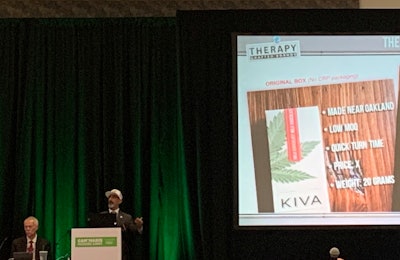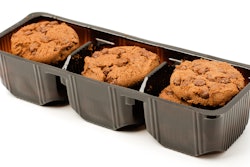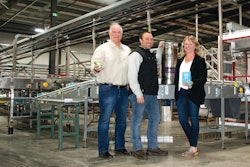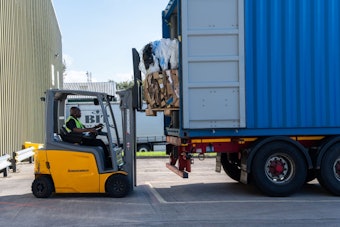Navigating the packaging landscape can be a challenge for cannabis brands when scaling up. Even celebrities hit stumbling blocks—recently, Whoopi & Maya, Whoopi Goldberg’s cannabis company closed.
While the company had multiple issues, packaging in an emerging industry was cited. “Suddenly we’re jumping through hoops like every other company in California,” Board Member Rick Cusick said to CNN Business. “We were well on the way to [being cash-flow positive] but then we had to jump through hoops to change our packaging … and then change our packaging again.”
In a recent panel at the CannaPack Summit co-located with WestPack in Anaheim, a brand owner shared some lessons learned.
MOQs
Big minimum order quantities (MOQs) that packaging/print suppliers require represent a hurdle, particularly for smaller companies who need to access packaging at affordable rates. “One of the really big problems overarching the cannabis industry is scale,” said Chris Coggan, CEO and lead designer of Therapy Tonics. Coggan is well-versed in packaging with 30 years of design experience, and holds a board position with the California Cannabis Industry Association (CCIA) heading their manufacturing committee.
Though California represents a huge portion of the global cannabis industry, companies are limited to the state, so they don’t have large packaging orders that will go country-wide or international. (Noted in our coverage from the CA Cannabis Business Conference.)
“We manufacture beverages. In our case beverages worked only because we were able to use equipment from the craft beer industry, but a lot of the other elements in manufacturing [are quite costly]—steam tunnels are $80,000. If you want a filling machine that's all unmanned, or a nitro head, you're spending hundreds of thousands of dollars,” he noted.
This is where semi-automated or small benchtop machines can bridge the gap, but there’s often sticker shock when companies try to scale. Producers go from doing everything manually, “or with hand cappers, and then you have to spend a few hundred thousand dollars to get to the next level, which can produce 50,000 units every two hours, but really you're doing a batch of 3,000 units, and you need it done in one day. So there's a lot of problems with scale in building cannabis,” he explained.
Coggan said they pay a premium for packaging. “It's actually a catch 22, because in the cannabis industry, if you really want it to stand out on the shelf, you have to invest in packaging. The problem is if you're a small brand trying to get started, especially with bootstrap money like ours, you can't afford to make those custom solutions because of the minimum order quantity. So you have to depend on the same old standards that everybody else is using, and it's really hard to grow a brand that way, because ultimately the first thing these consumers see, as it relates to your product, is that packaging, and if you can't stand out, you're screwed.”
Therapy Tonics has worked with their printer to reduce their MOQs to a number that’s more sustainable, and while they still pay a premium, he said it’s “a lot less than we would've been paying a few years ago, because they understand where we're at, and they understand where the industry is at right now too.”
Drop shipping and mail
Drop shipping in California makes sense to Coggan, but because of the regulatory landscape he predicts that the state is years away from that. He said, “There are some ancillary business models where they're building online stores, and people can order online, and then those orders are sent out to dispensers within a certain geolocation, and those dispensers have the option to fill that order, things like that. That's as close as you're going to get to drop shipping.
Mailing cannabis products is illegal and could very well get you a letter from the FBI. He added, “I don't think shipping is going to happen anytime soon. Within California and beyond, people use UPS and use FedEx, but it's totally illegal.”
Don’t overlook the dispensary
And with everything behind the glass in a dispensary, how does the uniqueness of the packaging factor in?
Coggan said their packaging reinforces their brand values, commitment to excellence, and more, but the answer depends on the market you’re involved in. “If you're talking about the vape market, you might walk into a shop, there's 50 different vape cartridges. What really matters in that case is the guy behind the counter, and which vape cartridge he's going to recommend you.”
It’s tricky, he said, because the demographics are all over the map. “In the sense that you've got 21 year olds, you've got 70 year olds, you've got everything in between. You have professionals, you have students. So it's challenging to bring elements together that are going to have appeal to everybody, and not offend anybody, right? For instance, in our new packaging we brought in a racing stripe, because it's kind of nostalgic from the fifties but it also speaks to the cars generation.”
The design mixed in a font reminiscent of coffee since it’s a coffee drink, with some street style that resonates more with millennials.
But he cautioned not to overlook one key factor: “The person that really matters is that budtender behind the counter.” His company will sit with them for a few hours to teach them about all the products. “When you do events, when you go to the shops, those are the people that you buy lunch for. Those are the people you give free T-shirts to. Those are the only people that matter, and at the end of the day, the most beautiful package in the world could just sit on that shelf collecting dust if the budtender’s not really into it. So, again, this is an opportunity from a strategy perspective.”
Beyond cost, key supplier elements to look for
While the number one element is cost, Coggan places a high value on being able to sit down face-to-face with suppliers. Communication and having direct relationships is key for him—being able to go to lunch and talk about options and the future is a big deal. He said, “We're able to work through projects together, and have direct relationships with the mold makers and the dye makers for things that are custom, and ultimately all of those relationships are really what I'm looking for.”
Close proximity also factors into logistics costs. “We used to get all of our shrinks made on the East coast with a really good company. It was probably about 40% cheaper than what we pay now, but what we pay now is local,” he explained. He can rent a truck, drive to pick up the order, and it’s done that day, instead of paying $1,600 for shipping.
Quick turn time is really important. Coggan noted, “As I've mentioned previously, we're usually under the gun, and trying to get stuff to market really quickly, and a lot of mistakes happen. I don't care how many people look at your packaging and edit it… things happen all the time. So you need somebody that's willing to address those issues in real-time, because every minute your product is not on the shelf, or not properly packaged is a minute that you're not selling.”
For more on cannabis packaging, check out our recent case studies:
Packaging is the Vehicle in Dogwalkers’ Brand Journey
Harvest Health Automates Cannabis Pouch Filling
Cannabis Brand Garden Society Incorporates Recyclable, Child-Resistant Packaging


























